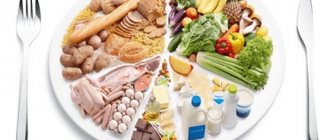What pressure is considered high
The perception of high blood pressure may vary from person to person. For example, some patients experience discomfort already at 130/85 mm. rt. Art., while in others even a pressure of 145/95 does not cause changes in well-being. In medicine, there is a diagnosis of “arterial hypertension,” which involves an increase in systolic pressure from 140 mm. rt. Art. and and/or 90 mm. rt. Art. and above - diastolic. There are two meanings, because a person’s heart either contracts (then the blood pressure becomes higher) or relaxes (the pressure becomes lower). The contraction of the heart muscles and the ejection of blood is called systole (hence the “systolic” pressure), and the relaxation and filling of the heart cavity with blood is called diastole (Fig. 1).
Figure 1. Heart function - systole and diastole. Source: Prog. Biophys. Mol. Biol. 2021, 138, 45–58
It is important to understand that the criteria for arterial hypertension are largely conditional.
Moreover, even normal pressure has several gradations (Table 1) Table 1. Classification of blood pressure levels (mm Hg) *Isolated systolic hypertension, in turn, is divided into three degrees depending on how elevated the systolic HELL.
| Blood pressure categories | Systolic blood pressure | Diastolic blood pressure |
| Optimal | below 120 | below 80 |
| Normal | 120-129 | 80-84 |
| High normal | 130-139 | 85-89 |
| Arterial hypertension 1st degree | 140-159 | 90-99 |
| Arterial hypertension 2 degrees | 160-179 | 100-109 |
| Arterial hypertension 3 degrees | 180 and above | 110 and above |
| Isolated systolic arterial hypertension | 140 and above | below 90 |
How to measure blood pressure
You can measure your blood pressure at home using a special device called a tonometer. High blood pressure can pose a health hazard, so every home medicine cabinet should have a blood pressure monitor. There are two types of tonometers:
- Mechanical. Good old classic. Less convenient to use, but give more accurate results.
- Electronic (automatic and semi-automatic - Fig. 2). Battery operated. The main advantage is that you do not need to listen to heartbeats yourself (which is sometimes quite difficult to do due to weak pulse filling). But such devices also have a big disadvantage - the measurement results are not always accurate. When re-measured, the numbers may vary slightly.
Figure 2. Electronic automatic blood pressure monitor. Source: CC0 Public Domain
How to use a mechanical blood pressure monitor
In order to measure pressure with a mechanical tonometer (video 1), you need:
- sit in a comfortable position and relax, while your arm should be bent at the elbow joint and lie on a flat surface,
- remove the shoulder part of the arm from clothing and fasten the cuff on it (its lower edge should be 3-4 cm above the elbow bend),
- place a stethoscope (phonendoscope) on the inside of the elbow joint in the place where the pulse can best be felt,
- using a hand pump, start pumping air into the cuff,
- bring the pressure gauge needle to values exceeding the expected pressure by 30-40 mm. rt. Art. (for example, if the patient’s normal blood pressure is 135/90, then you can stop at 170),
- slowly release air from the cuff, waiting for tones to appear - these are the sounds of a heartbeat; their appearance marks the boundary of systolic pressure, and their disappearance marks the boundary of diastolic pressure. Simply put, if tones appeared at number 150 and disappeared at number 100, then the result is 150/100).
Video 1. How to correctly measure pressure with a mechanical tonometer.
In the absence of a stethoscope, the upper (systolic) pressure can be measured by monitoring the behavior of the needle. You need to notice the reading when she starts to twitch. However, this method is not very reliable, since the needle often begins to tremble before the first strong audible beat of the pulse.
If you want to visit the toilet before measuring your blood pressure, it is better not to deny yourself this, since an overfilled bladder increases your blood pressure by about 10 points. It is also important not to take the measurement immediately after intense physical activity or immediately after sleep. If the pressure is too high or too low, the result should be rechecked 3 times with an interval of 5-10 minutes. After that, calculate the average values - this is your result. Morning pressure should be measured before and after breakfast, also taking the average value.
Home diagnosis of the condition
Before giving a person pills or using home remedies, the blood pressure must be measured. For these purposes, a semi-automatic or automatic tonometer is best suited, which should be in the first aid kit of every hypertensive or hypotensive patient, including potential ones.
To assess the condition, it is important to take into account all indicators of the device - systolic and diastolic pressure, pulse rate. The optimal blood pressure values are considered to be 120 to 80 mm Hg. Art. However, they are averages and may vary depending on age, level of physical activity, gender, the presence of concomitant diseases and even the foods consumed.
Table of blood pressure norms by age
If the tonometer readings differ from the optimal values by more than 15 mm Hg. Art., a person feels unwell, then it is worth quickly taking measures to provide him with first aid. This also applies to situations where only cardiac (upper) or only renal (lower) pressure is increased. In the case when the difference between the systolic and diastolic indicators is different from normal - about 40 mm Hg. Art., you must inform your doctor about this, since such a symptom may indicate serious problems in the functioning of the heart or kidneys.
If high blood pressure bothers you several times a month, this is a reason to undergo an examination to identify the cause of the condition and create a treatment plan. At the initial stage of primary hypertension, the problem can be solved without the help of medications. The emphasis is on salt-free nutrition, physical activity, and psycho-emotional relaxation.
Secondary hypertension occurs as a symptom of diseases of the cardiovascular system, endocrine, and urinary systems. It is possible to cope with fluctuations in blood pressure after a comprehensive diagnosis only if the underlying disease is treated at the same time.
No ads 1
Consequences of high blood pressure
High blood pressure is dangerous primarily because blood vessels lose their elasticity, and this can lead to their rupture and stroke (impaired blood supply to the brain). In addition, increased blood pressure is fraught with the development of the following complications:
- visual impairment due to deterioration of blood supply to the retina,
- complete loss of vision as a result of hemorrhage in the vitreous and/or retina,
- angina pectoris - pain in the heart due to impaired blood supply to the myocardium,
- hypertrophy of the left ventricle of the heart,
- heart attack - death of a section of the heart muscle as a result of disruption of its blood supply,
- heart failure - the systole-diastole cycle, which we wrote about above, is disrupted, which leads to a deterioration in the outflow of blood and filling of the ventricles,
- renal failure - develops as a result of deterioration of blood supply to the kidneys,
- deterioration of the general condition of the nervous system (irritability, fatigue, tendency to depression),
- disruptions in brain function as a result of deterioration of the cerebral vessels can be fraught with a decrease in intellectual abilities up to the development of so-called vascular dementia (dementia resulting from chronic cerebral circulatory failure).
Reasons for the increase
Heart pressure increases for various reasons, including:
- Myocardial diseases. High lower pressure may be associated with a deterioration in the contractile function of the left ventricle, which occurs in diseases such as heart attack, myocarditis, and myocardiosclerosis. If the venous outflow of blood to the heart is disrupted, this negatively affects the functioning of the heart muscle. As a result, only cardiac pressure increases, while systolic pressure remains normal, since the ejection of blood from the heart does not change.
- Thyroid diseases.
- Kidney pathologies are often accompanied by an increase in lower pressure. This is due to the fact that in case of kidney diseases, the blood flow in them decreases, and this leads to increased release of a bioactive substance (renin), which increases the tone of peripheral vessels. Thus, the resistance of the arterial walls increases, and with it the heart pressure.
- Spinal diseases.
- Obesity.
- Taking certain medications.
Dangerous symptoms
An elderly woman with a severe headache.
Photo: dusanpetkovic / freepik.com Some people have asymptomatic increases in blood pressure, but in most cases the following signs are observed:
- weakness and fatigue,
- pressing or throbbing headache in the occipital and/or temporal part,
- nausea,
- dizziness,
- chest pain,
- noise in ears,
- shortness of breath during habitual physical activity,
- numbness of the limbs,
- blurred vision, flashing spots before the eyes,
- irritability,
- increased sensitivity to light (sometimes to sounds).
The appearance of even one or two of the symptoms listed above should be a cause for concern. Some people prefer to simply “endure” an episode of high blood pressure “so as not to be poisoned by all this chemistry” (that is, pills). But such manifestations cannot be ignored, since, as we said above, high blood pressure is fraught with a number of dangerous consequences.
Why does lower blood pressure increase?
Forms of arterial hypertension (AH) with a predominant increase in diastolic lower blood pressure account for approximately 20% of all types of this disease.
This type of headache is characterized by severity, resistance to therapy and requires an individual approach in each case.
Mostly, an increase in DBP is accompanied by secondary (symptomatic) hypertension - an increase in blood pressure due to internal diseases (unlike essential hypertension, the cause is found).
For continuous and efficient blood flow throughout the vascular system, the heart needs to push a constant volume of blood out of the left ventricle with a certain force (systolic blood pressure), and the aorta must adapt to the ejected mass by narrowing or stretching (diastolic blood pressure). The difference between SBP and DBP should range between 40-50 mmHg. Art.
Diastolic blood pressure is formed from:
- circulating blood volume;
- elasticity of the walls of blood vessels;
- the effectiveness of the period of myocardial relaxation (diastole);
- activity of nervous and hormonal regulation of arteriolar tone.
An increase in DBP is sometimes temporary (in this case there is no primary damage to internal organs). Reasons for this condition:
- excessive salt intake (more than 8 grams/day);
- abuse of alcoholic beverages and coffee;
- overweight, obesity;
- water overload of the body (consumption of more than 30 ml/kg/day);
- stressful situations, lack of sleep.
When the diet and daily routine are normalized, DBP levels return to normal on their own. Symptoms of elevated DBP:
- Dull, aching headache in the back of the head and temples, which intensifies with sudden turns and tilts of the head.
- Dizziness, tinnitus, buzzing in the head.
- Transient visual impairment.
- Sensation of squeezing in the region of the heart.
- Rapid pulse.
- Shortness of breath, dissatisfaction with inhalation.
- Increased fatigue, decreased ability to work, apathy, emotional lability, anxiety, sleep disturbances.
A prolonged, persistent increase in diastolic blood pressure accompanies:
- Myocardial diseases, which are characterized by a decrease in the contractility of the heart muscle (cardiosclerosis, cardiomyopathy, left ventricular infarction, myocarditis).
- Dysfunction of endocrine organs (thyroid gland, adrenal glands, ovaries in women during menopause).
- Late gestosis during pregnancy.
- Kidney diseases (vascular pathologies or direct tissue damage).
- Neurological diseases (intracranial hypertension, sleep apnea, encephalitis, tumors, traumatic brain injuries).
- Blood diseases (anemia, polycythemia).
- Taking certain medications (glucocorticosteroids, thyroid hormones, non-steroidal anti-inflammatory drugs, oral contraceptives, tricyclic antidepressants, MAO inhibitors).
High diastolic blood pressure is more common in patients with type II diabetes mellitus and advanced atherosclerosis.
Arterial hypertension with predominantly high DBP develops in young patients (starting from 30-40 years).
Let's look at the most common diseases that cause an increase in diastolic blood pressure:
- Kidney diseases. Inflammatory or autoimmune damage to organ tissue leads to disruption of blood filtration and water secretion. As a result, circulating plasma volume and sodium concentration progressively increase. Impaired blood supply to the kidneys triggers the secretion of renin, which provokes the release of angiotensin-II (a powerful vasoconstrictor) in the blood. This process causes the most severe course of diastolic hypertension (DBP exceeds 100 mm Hg).
- Diseases of the endocrine system. Tumors and adrenal dysfunction disrupt the natural balance of adrenaline, cortisol and aldosterone, which, by affecting arteriolar tone and the processes of water and sodium reabsorption, increase diastolic blood pressure. Hypothyroidism – decreased production of thyroid hormones increases total vascular resistance and DBP.
- Heart diseases. A decrease in the mass of the functioning myocardium (due to inflammation or infarction) reduces the overall speed of blood flow and provokes stagnation in the venous and arterial vessels. Insufficiency of the aortic valves disrupts the continuity and unidirectionality of blood flow through the vessels, ultimately leading to stagnation in both circulation circles. Arterioles affected by cholesterol plaques become rigid and resistant to the influence of vasoactive hormones. Additionally, blood supply to internal organs (heart, brain, kidneys) is reduced. In diseases of the nervous system, the central regulation of vascular tone by the medulla oblongata is disrupted.
- Drug-induced diastolic hypertension. Some drugs can change the activity of the sympathetic nervous system, the balance in the secretion of renin-angiotensin-aldosterone and adrenal hormones.
Diastolic pressure norms
In order for blood to leave the heart cavity at a sufficient speed, move through the arterioles and reach all small capillaries, the vascular wall needs to “maintain” diastolic blood pressure within the range of 60-89 mm Hg. Art. This indicator is primarily formed by the amount of tone of the so-called resistive vessels.
The DBP indicator characterizes the activity, elasticity, patency of the body's blood vessels and the functional state of the kidneys and sympathetic nervous system.
Degrees of hypertension depending on the value of DBP:
| Arterial hypertension category | DBP value (mm Hg) |
| Optimal blood pressure | 60-79 |
| Normal | 80-84 |
| Prehypertension | 85-89 |
| AH I degree (mild) | 90-99 |
| AH II degree (average) | 100-109 |
| AH III degree (severe) | Above 110 |
Reducing blood pressure at home
Many people who have not previously experienced problems with blood pressure or simply did not pay attention to headaches and other symptoms usually do not know what to do if the tonometer readings confirm unpleasant fears. The main rules of behavior: calm and deep breathing. To make it easier for the brain to receive oxygen, the apartment of a hypertensive patient should be well ventilated. A cold compress on the neck and forehead will help relieve the condition.
As a one-time help, you can take a drug from the group of angiotensin-converting enzyme blockers in combination with an anesthetic drug (paracetamol, ibuprofen). However, cardiologists do not recommend treatment in this way on a regular basis. The choice of medications to lower blood pressure should be agreed with a doctor - he will be the one who will help you choose the necessary drug, which should always be in your home medicine cabinet.
Pills and medicines
Drugs to lower blood pressure are divided into several groups. Let's look at them in detail.
ACE inhibitors
Angiotensin-converting enzyme inhibitors are one of the most popular drugs in the treatment of hypertension. These drugs interfere with the conversion of the enzyme angiotensin 1 to angiotensin 2, which narrows the lumen of blood vessels. The mechanism is simple: the blood vessels do not narrow - the pressure does not increase. There is also a gradation among ACE inhibitors:
- First generation drugs: Captopril, Benazepril, Zofenopril.
- Second generation drugs: Lisinopril, Ramipril, Enalapril.
- Third generation drugs: Monopril, Fozinap, Fozinotec.
Alpha blockers
The sympathetic-adrenal system is responsible for changes in blood pressure in the body. The adrenal glands and hypothalamus produce adrenaline and norepinephrine, neurotransmitters that, among other things, regulate the functioning of the cardiovascular system. They stimulate the heart rate and increase blood pressure.
Alpha blockers, as the name suggests, help reduce the sensitivity of specific alpha receptors to adrenaline and norepinephrine, thereby reducing blood pressure. The most well-known drugs are Doxazosin and Prazosin.
Beta blockers
Unlike alpha-blockers, drugs in this group block beta receptors located not only in the arteries, but also in the heart. The principle of action is the same, as well as the therapeutic effect: dilation of blood vessels, facilitation of blood flow and subsequent decrease in pressure, as well as a decrease in the frequency and force of contraction of the heart muscle. Preparations:
- Bisoprolol,
- Betaxolol,
- Metoprolol,
- Nebivolol.
Diuretics
Due to their diuretic effect, diuretics reduce the load on the heart. In addition, they have a vasodilating effect, which, as we already know, is also used to reduce blood pressure. Experts have different opinions regarding the use of diuretics to lower blood pressure: some consider them first-line drugs along with adrenergic blockers, others are convinced that the use of diuretics in the treatment of hypertension is a thing of the past, since drugs in this group disrupt the electrolyte balance. The following groups of diuretics are distinguished:
- Loopbacks. They have a strong but short-term effect. In the treatment of arterial hypertension, they are used in patients with renal failure. The most commonly used are Furosemide and Torasemide.
- Potassium-sparing. Unlike other diuretics, they do not remove potassium from the body, although their diuretic effect is slightly weaker. Drugs: Spironolactone, Amiloride.
- Thiazide. This type of diuretic is used most often in the treatment of hypertension. The potency of action is inferior to loop diuretics, but superior to potassium-sparing diuretics. The most common drugs: Hydrochlorothiazide, Cyclopenthiazide.
- Osmotic. This type of diuretic for hypertension is prescribed much less frequently and is usually used in hospital treatment. The most commonly used are Sorbitol and Mannitol.
Calcium antagonists
Since imbalance of calcium and its excess in the blood plasma is considered a predisposing factor to increased blood pressure, drugs of this group are actively used in the treatment of hypertension. They prevent calcium from entering cells, thereby normalizing blood pressure. And there is a gradation here:
- Dihydropyrines: Amlodipine, Nifedipine.
- Phenylalkylamines: Verapamil, Gallopamil.
- Benzodiazepines: Diltiazem, Clentiazem.
Heart medications for high blood pressure
For hypertension, ACE inhibitors, alpha-blockers, beta-blockers and calcium antagonists are used - all of them are “heart” drugs, since they are prescribed in the treatment of pathologies such as coronary heart disease, left ventricular dysfunction and chronic heart failure. In addition to the medications already listed above, you can add here:
- Lercanidipine,
- Valsartan,
- Aliskiren,
- Carvedilol.
The choice of medications to lower blood pressure should be agreed with your doctor. Photo: towfiqu999 / freepik.com
Folk remedies for quickly reducing blood pressure
If there are no medications at hand, and the increase in pressure does not indicate a hypertensive crisis, you can use traditional methods, although they are inferior in effectiveness to drug treatment. Here are some of the most common methods:
- Mustard plasters on the shin. Due to blood flow to the legs, a slight hypotensive effect is achieved.
- Compress with apple cider vinegar. Folded gauze or a towel is soaked in apple cider vinegar and applied to the feet. From the point of view of evidence-based medicine, the method is questionable, but some patients claim that it has an effect.
- Breathing exercises. For several minutes, you need to inhale and exhale slowly, taking a comfortable position and closing your eyes. Exhale should be done with the stomach, not the chest. This relieves nervous tension and improves peripheral blood supply.
- Pressure also helps reduce massage of the collar area. However, unlike the classic version, stroking movements should be performed with a little more pressure and directed downwards - from the neck to the lower back.
What causes high blood pressure
For most people, there is no single cause for high blood pressure. However, there are a number of factors that increase the likelihood of developing hypertension. These are the so-called risk factors - controllable and uncontrollable. You can adjust:
- . When a person smokes, the incoming nicotine increases blood pressure. Over time, this damages the arteries, increasing the risk of heart attack or stroke.
- Eating excess processed foods and salt. Many processed foods contain a lot of salt. Excess salt intake causes the body to store excess water, which increases blood pressure.
- Drinking excess alcohol too often. Drinking alcohol temporarily increases blood pressure. Excessive alcohol consumption on a regular basis can lead to hypertension.
- Excess weight. Excess weight increases the risk of high blood pressure. Even losing just a few pounds can lower your blood pressure.
- Insufficient activity. If a person moves more and sits less, blood pressure decreases.
- . Hormones produced by the body during stress increase blood pressure. Researchers are still trying to understand the exact link between long-term high blood pressure and ongoing stress.
Uncontrollable risk factors include:
- . If a patient has type 1 or type 2 diabetes, they are twice as likely to develop high blood pressure.
- Kidney disease or other gland problems. Sometimes a serious disease that affects the kidneys, arteries, heart, or endocrine system can cause high blood pressure.
- Aging. Blood pressure naturally increases with age.
- Taking certain medications, such as birth control pills.
- A parent or sibling with high blood pressure. High blood pressure runs in families, so if parents or siblings have problems, the risk of hypertension increases.
Urgent Care
If the pressure is significantly elevated, the patient should first calm down, and then ensure a flow of fresh air into the room and take a comfortable position. Clothes should be loose, special attention should be paid to the collar.
The sequence of actions to alleviate hypertension is very simple:
- Calm down, don't panic.
- Organize access to fresh air (open a window, go outside).
- Optimize breathing (deep breath, hold, exhale).
- Apply a cold compress to the forehead, temples and back of the neck.
- Take a sedative: 50 to 100 drops of Valocordin or Corvalol, extract or tincture of motherwort (valerian).
- Wait 20-30 minutes, measure the pressure again.
- In case of high blood pressure, take medicine to lower blood pressure (for example, from the group of ACE blockers).
When to call an ambulance
If 30-40 minutes after taking the medication the condition does not improve, you should call an ambulance. Indications for calling are blood pressure of 180/110 or higher, shortness of breath, headache, nausea, rapid heartbeat and chest pain. You need to call 003 or 112 and describe all the symptoms to the dispatcher in detail.
Injections for hypertension
Injections are used for hypertensive crises (a serious condition caused by an increase in blood pressure from 180/110 and above) to quickly reduce blood pressure. During the Soviet Union, the favorite remedy for emergency doctors in such situations was a combination of papaverine, metamizole sodium and diphenhydramine, known as “troychatka.” It is still used today, but modern cardiologists insist that there is no need to inject this mixture into everyone: first of all, it is important to find out the reason for the sharp increase in blood pressure - this will help to choose the right drug.
For example, if the attack was provoked by severe nervous tension, then the drug of choice will be diazepam (administered both intramuscularly and intravenously). In case of a convulsive form of crisis, a so-called hot injection - magnesium sulfate (slowly intravenously) is added to diazepam.
A hypertensive crisis can be caused by excess fluid accumulation (edematous, or water-salt form). In this case, an injection of furosemide is given in combination with nifedipine (sublingually).
In the neurovegetative form (adrenal crisis), sublingual nifedipine is usually used first, and in the absence of the expected effect, an injection of clonidine is given.
When is it necessary to call an ambulance?
Emergency assistance must be called if such an attack:
- happened for the first time;
- the antihypertensive drug did not have an effect on high blood pressure within 30-60 minutes;
- the pressure increased to a critical level (for hypertensive patients - up to 160/95 mm Hg, for hypotensive patients - up to 130/85 mm Hg);
- signs of hypertensive crisis appeared.
In this case, high blood pressure can lead to health and even life-threatening complications, such as stroke, heart attack, pulmonary edema, and cerebral edema. Too low blood pressure, which can be caused by taking a large amount of antihypertensive drugs, can also lead to serious consequences, so in case of severe hypotension, you should call a doctor and remove the person from this condition.
Diet
It is necessary to limit the consumption of salt and foods rich in sodium (fatty meat, seafood, eggs). Alcohol, coffee and energy drinks are also not recommended for consumption. The diet should be enriched with plant fiber and low-fat lactic acid products. It is also necessary to consume more foods rich in potassium (bananas, spinach, garlic).
People with high blood pressure are advised to eat more vegetables and fruits. Photo: prostooleh / freepik.com
Lifestyle
It is strongly recommended to quit smoking. You need to learn to avoid stress and sleep at least 8 hours a day. To strengthen the cardiovascular system, you need to engage in moderate physical activity, since physical inactivity is one of the factors predisposing to the disease. In addition, physical activity combined with a healthy diet helps normalize body weight. This is a relevant question because overweight people are predisposed to hypertension. Nasal sprays should be used with caution - they increase blood pressure (not to mention the ability to cause addiction). It is recommended to take dietary supplements such as L-carnitine, hawthorn extract, coenzyme Q10 and fish oil.










